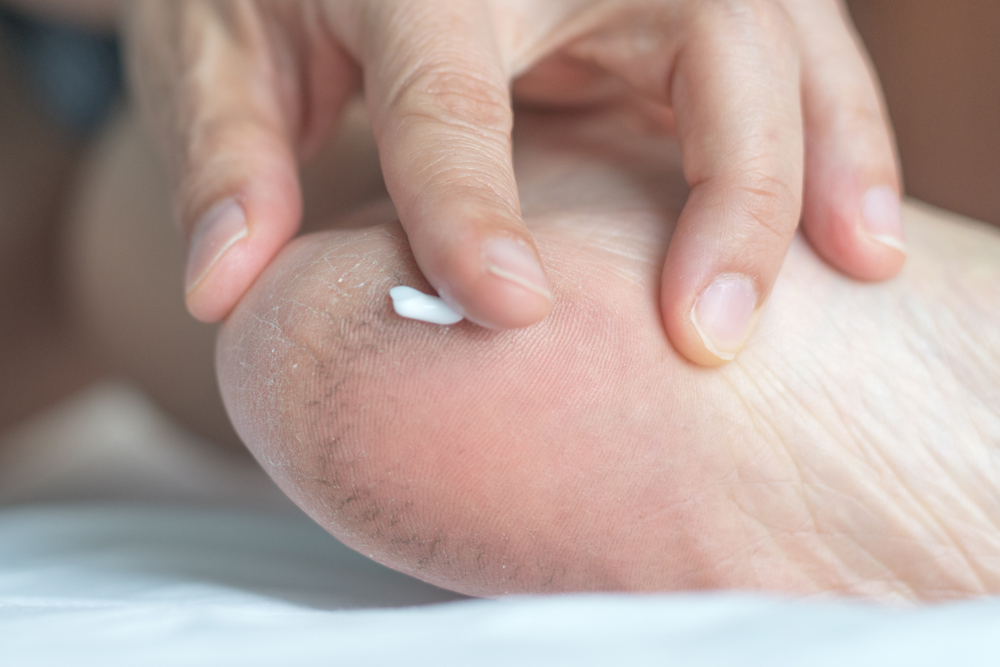- Cracked heels occur when the skin is excessively dry and callused.
- Diabetes and medical conditions that cause poor blood flow can worsen the conditon.
- At-home remedies include moisturizers, exfoliants, and keratolytics.
- Individuals with underlying medical conditions must seek professional treatments.
Cracked heels — also known as heel fissures — occur when the skin around the heel’s edge dries out, thickens, and develops yellow or brown calluses.
Usually, cracked heels are simply dry and unattractive, but in certain cases they can cause pain, discomfort, and even bleeding.
Fortunately, there are several at-home remedies that can treat cracked heels before they worsen and split open.
Everyday causes of cracked heels
Cracked heels begin with dry and callused skin. Everyday causes include taking long showers, using harsh soaps, and living in a dry climate.
Once the skin dries out, putting pressure on the heel can cause it to split. That’s because as you walk, the fat pad under your heel (a little “pillow” of fat that cushions the heel bone as you move) expands, causing the already-dry skin to crack into fissures.
Standing for long hours, walking barefoot or in open-backed shoes, and wearing improperly-fitting shoes that fail to support your heels can also contribute to the heel skin splitting.
Medical causes of cracked heels
“Cracked heels are basically due to severe dry skin. Any skin disorder that causes skin drying can be a risk; eczema is a good example,” explains Dr. Susan Besser, a primary care provider at Mercy Personal Physicians at Overlea, in Baltimore.
“Chronic conditions or peripheral vascular diseases that affect blood flow to the area can be also be contributing factors,” Besser adds.
Of these conditions, diabetes is one of the most common culprits.
High blood sugar and poor circulation — two symptoms of diabetes — can lead to dry skin and cracked heels. To make matters worse, diabetes can cause nerve damage in the feet and prevent you from feeling pain as the issue becomes more severe.
“Over 20 million Americans suffer from diabetes,” says Dr. Bruce Pinker, a board-certified foot and ankle surgeon at Progressive Foot Care in White Plains, NY. “With severe cracking of the heels, the skin can break and ulcerate, leading to infection. Diabetics, due to their reduced immune systems, are more susceptible to infection.”
Other possible medical causes include aging, atopic dermatitis, fungal infection, hypothyroidism, obesity, pregnancy, psoriasis, and vitamin deficiency.
Remedies for cracked heels
Home remedies are ideal for treating this condition. However, if you experience soreness, redness, swelling or severe pain in any area of the foot for more than a few days, you should see a doctor or podiatrist.
Here are seven treatments you can use to address your cracked heels at home.
Emollients and humectant moisturizers
Cracked heels are caused by dryness, therefore combat dryness with a moisturizer. There are two types to look for: emollients and humectant moisturizers.
Emollients reduce water loss by penetrating the skin and filling the gaps between skin flakes — with the added bonus of making the skin feel smooth, soft, and flexible.
Humectants also penetrate the outer skin layer, but rather than reducing water loss, they attract and retain moisture from the air and increase the water capacity of the skin. However, if you live in a dry environment where there’s not a lot of moisture in the air, the humectant may draw moisture from lower layers of skin instead of the air, worsening the dryness.
Occlusive moisturizers
Occlusive moisturizers also seal in moisture, and can be applied over the emollient and humectant moisturizers. They tend to be thicker than emollients and may not absorb into the skin entirely.
There are several occlusive moisturizers available, including petroleum jelly (Vaseline).
Petroleum jelly is inexpensive and an incredibly effective moisturizer, reducing water loss from the skin by 98%. However, occlusive moisturizers can be messy to apply, and are not absorbed into the skin very quickly.
To avoid getting it everywhere, you can apply petroleum jelly to your heels before bed and don socks — this will keep the moisture in and your sheets clean.
Moisturizing heel sleeves
These products are like a partial sock and a moisturizer rolled into one. The fabric or silicone gel is usually infused with therapeutic oils and other moisturizing elements, but the heel sleeves can also be paired with an additional moisturizer to speed up the healing process even more.
Because of the sleeves’ design, they are meant to be worn while resting, sleeping, and otherwise not moving around on your feet.
Exfoliation
Exfoliating with a pumice stone, loofah or foot scrub can help reduce calluses on the heel as well as reduce the thickness of skin.
Exfoliate after showering, when the skin is wet and softened. You can also apply moisturizer before using the pumice stone or another exfoliating agent.
Keratolytics
Thickened skin can also be reduced in a different way — by using a keratolytic agent. Keratolytic products use acid to thin the skin, cause the outer layer to loosen, and help remove dead skin cells. Examples of keratolytic agents include lactic acid, glycolic acid, salicylic acid, and urea.
Urea is both a humectant and a keratolytic, which is why it’s so great for treating cracked heels. It removes the dry, thickened outer layer of skin while moisturizing the layers beneath.
Liquid bandages
Due to the curved shape of the heel, the constant movement of feet, and the weight put on the heels, regular bandages are impractical and uncomfortable.
If your heels are prone to bleeding, seek out liquid, spray, or gel bandages instead. These bandages provide a protective yet flexible layer, keeping out dirt and germs, and reducing pain.
Natural remedies for cracked heels
There are many natural and purportedly effective home remedies for cracked heels and dry skin, although very few have scientific evidence to back them up — at least for now.
- Olive or vegetable oil: Take a shower or wash your feet before bed, then apply a layer of oil to the cracks on your heels. Put on a pair of thick socks and wear them overnight. Wash feet in the morning.
- Mashed bananas: Mash a banana with a fork or use a blender. Apply to the cracked skin for 10–20 minutes. Wash feet with lukewarm water.
- Paraffin wax: Before bed, heat a tablespoon of wax with a few drops of coconut oil in a pot over low heat. Once cool to the touch, apply to cracked heels and cover with thick socks. Wash feet in the morning.
- Oatmeal: Mix dry oatmeal (not instant) with a few drops of olive oil. Rub on heel cracks and leave for about 30 minutes. Rinse with cold water and pat dry.
- Apple cider vinegar: Fill a tub or basin with enough warm water to cover feet and add one cup of apple cider vinegar. Soak feet for about 15 minutes, then scrub gently to exfoliate dead skin cells. Rinse with cold water.
Preventing cracked heels
Proper footwear is key to preventing cracked heels. Avoid flip-flops, sandals, and other open-back shoes, as well as shoes that are too tight or have a tall, skinny heel. Also try not to stand in one position for too long, and give your feet a rest when you can.
“Flip-flops abuse our heels as the footwear slaps into the rear of our feet on every step. It causes drying and, in severe cases, cracking,” Pinker explains. He also advocates drinking at least eight 8-ounce glasses of water a day to hydrate skin from the inside out.
If you’re prone to cracked heels, you might need to take extra preventative measures. This could include wearing custom inserts, padded socks or silicone heel cups, and inspecting your feet daily.
Moisturize your feet regularly and exfoliate with a pumice stone after showering to stave off cracked heels. If you have diabetes or neuropathy (nerve damage) don’t exfoliate or remove calluses yourself, as you could accidentally injure your foot and cause infection.
In many cases, cracked heels are merely cosmetic, and they will heal in a few days or weeks thanks to one of the at-home remedies listed above.
» See a doctor if you have a severe case of cracked heels, or if you have a medical condition such as diabetes. Meet our Medical Review Team and get online consultations before going for a cosmetic procedure..









